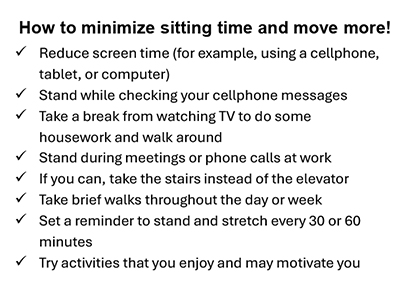
The National Institutes of Health (NIH) defines physical activity as, “any movement of the body that uses energy and works your muscles”. Some examples of physical activity include, walking, running, practicing yoga, lifting weights or practicing a sport. However, even people who practice physical activity regularly may spend too much time being sedentary. Sedentary behavior refers to activities you do while sitting or lying down, for example, binge-watching television, working in front of a computer, playing video games, driving, and laying down for long hours. Too much sedentary time can increase the risks for chronic diseases and premature death.
For an active lifestyle that benefits your health
For optimal health, it is recommended that all adults should do at least 150 minutes (2 hours and 30 minutes) of moderate-intensity aerobic physical activity per week, or at least 75-150 minutes of vigorous-intensity aerobic physical activity, or a combination of both, at least two days a week. Additionally, muscle-strengthening activities are also recommended for all age groups. Any amount of physical activity is better than none!
Light intensity: yoga, casual walking, stretching, light housework.
Moderate intensity: brisk walking, fitness dance, hiking, tennis.
Vigorous intensity: jogging or running, swimming, bicycling, soccer.
Muscle strengthening: lifting weights, climbing stairs, resistance bands, yard work.
How to minimize sitting time and move more!
- Reduce screen time (for example, using a cellphone, tablet, or computer)
- Stand while checking your cellphone messages
- Take a break from watching TV to do some housework and walk around
- Stand during meetings or phone calls at work
- If you can, take the stairs instead of the elevator
- Take brief walks throughout the day or week
- Set a reminder to stand and stretch every 30 or 60 minutes
- Try activities that you enjoy and may motivate you
Some benefits of increasing physical activity and decreasing sedentary behavior
Emotional:
- Improved sleep.
- Decreased anxiety, depression, and stress.
- Improved mood and self esteem.
- Increased feeling of energy.
Physical:
- Decreased risk of obesity.
- Improved heart health.
- Decreased risk of diabetes.
- Improved balance and coordination.
Resources
Move Your Way activity planner
San Diego County Healthy Living fitness programs
NIH: Health Benefits of Exercise and Physical Activity
CDC: What You Can Do to Meet Physical Activity Recommendations | Physical Activity Basics | CDC
WHO: Every Step Counts - Updated WHO Guidelines on Physical Activity and Sedentary Behavior
Miami, Florida 1-305-243-1828
Bronx, New York 1-718-584-1563
Chicago, Illinois 1-312-355-5320
San Diego, California 1-619-205-1926
Coordinating Center 1-919-962-3254
Hispanic Community Health Study / Study of Latinos (HCHS/SOL)
